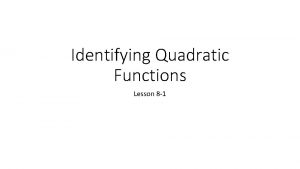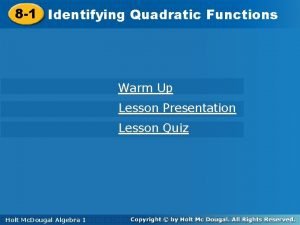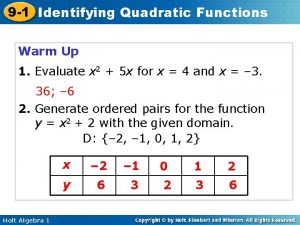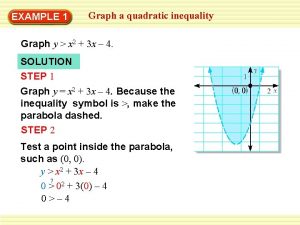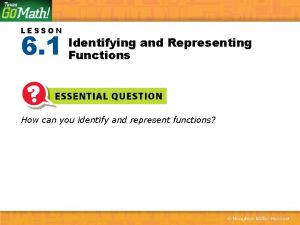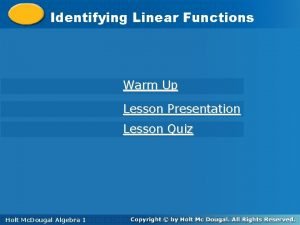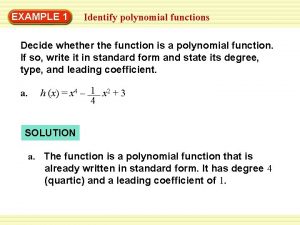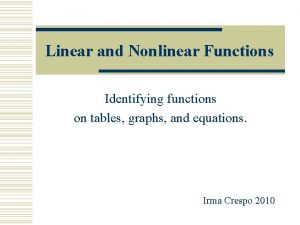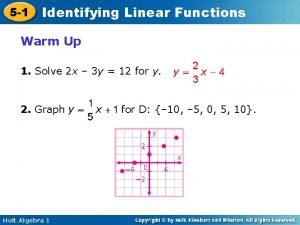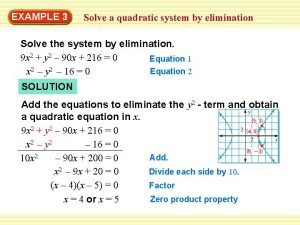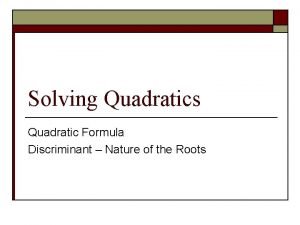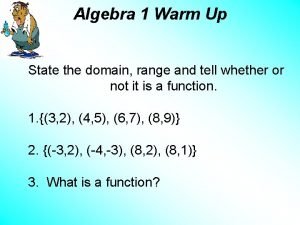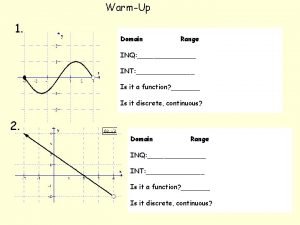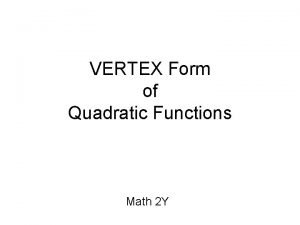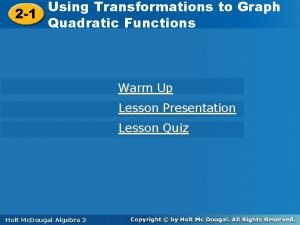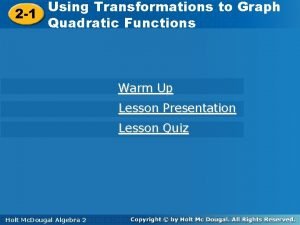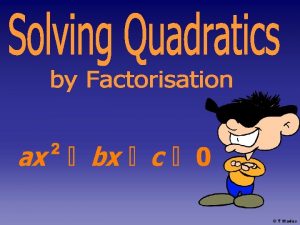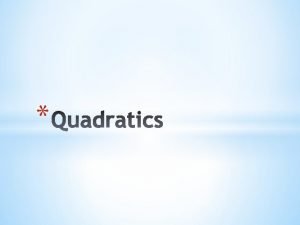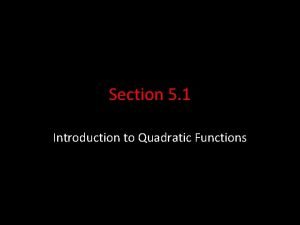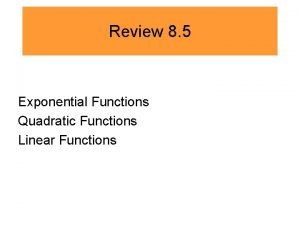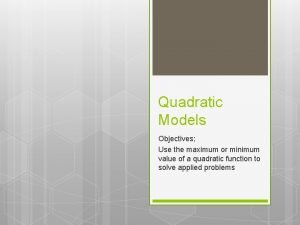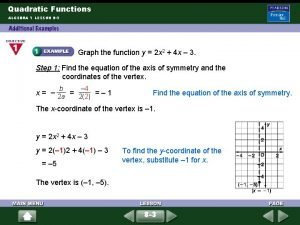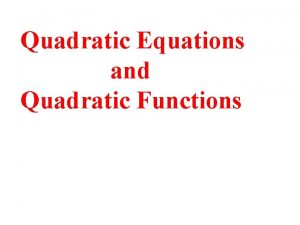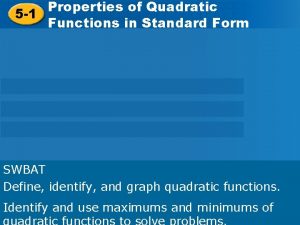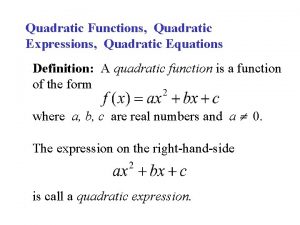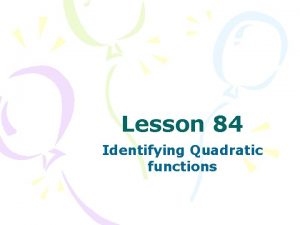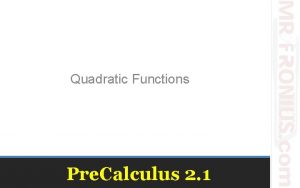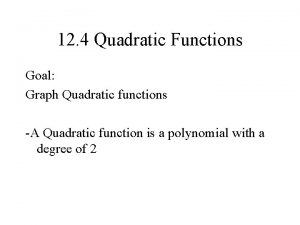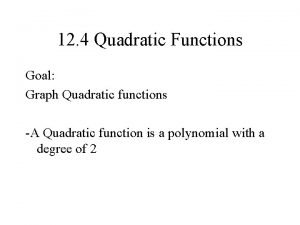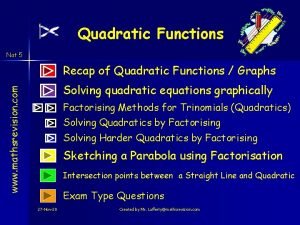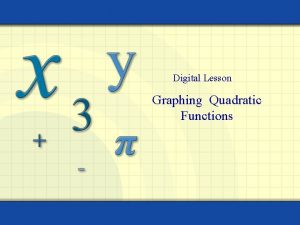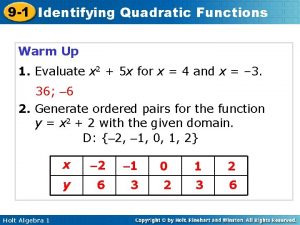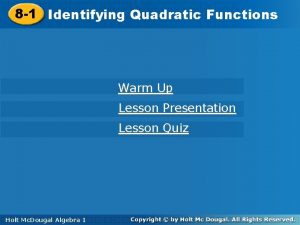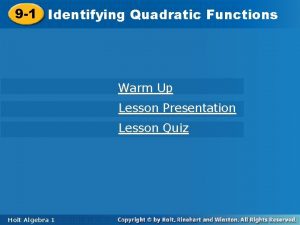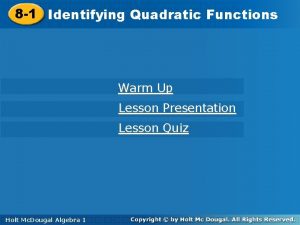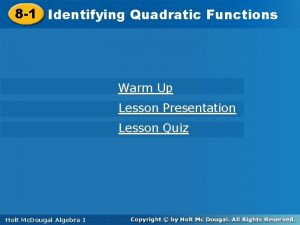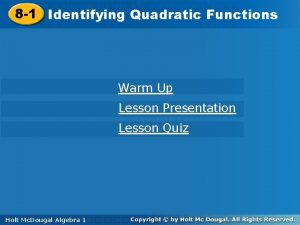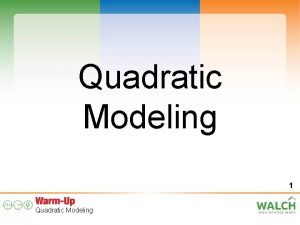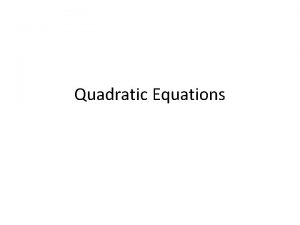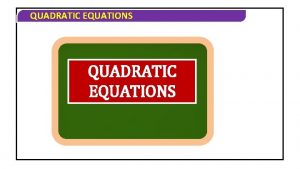9 1 Identifying Quadratic Functions Warm Up 1



























- Slides: 27

9 -1 Identifying Quadratic Functions Warm Up 1. Evaluate x 2 + 5 x for x = 4 and x = – 3. 36; – 6 2. Generate ordered pairs for the function y = x 2 + 2 with the given domain. D: {– 2, – 1, 0, 1, 2} Holt Algebra 1 x – 2 – 1 0 1 2 y 6 3 2 3 6

9 -1 Identifying Quadratic Functions Write the prime factorization of 98. 98 = 2 Holt Algebra 1 2 7

9 -1 Identifying Quadratic Functions Learning Targets Students will be able to: Identify quadratic functions and determine whether they have a minimum or maximum and also graph a quadratic function and give its domain and range. Holt Algebra 1

9 -1 Identifying Quadratic Functions The function y = x 2 is shown in the graph. Notice that the graph is not linear. This function is a quadratic function. A quadratic function is any function that can be written in the standard form y = ax 2 + bx + c, where a, b, and c are real numbers and a ≠ 0. The function y = x 2 can be written as y = 1 x 2 + 0 x + 0, where a = 1, b = 0, and c = 0. Problem Holt Algebra 1

9 -1 Identifying Quadratic Functions In Lesson 5 -1, you identified linear functions by finding that a constant change in x corresponded to a constant change in y. The differences between yvalues for a constant change in x-values are called first differences. Holt Algebra 1

9 -1 Identifying Quadratic Functions Notice that the quadratic function y = x 2 doe not have constant first differences. It has constant second differences. This is true for all quadratic functions. Holt Algebra 1

9 -1 Identifying Quadratic Functions Tell whether the function is quadratic. Explain. +1 +1 x y – 2 – 9 – 1 – 2 0 – 1 1 0 2 7 +7 +1 +1 +7 – 6 +0 +6 The function is not quadratic. The second differences are not constant. Holt Algebra 1

9 -1 Identifying Quadratic Functions Caution! Be sure there is a constant change in x-values before you try to find first or second differences. Holt Algebra 1

9 -1 Identifying Quadratic Functions Tell whether the function is quadratic. Explain. y = 7 x + 3 Standard Form y = ax 2 + bx + c, where a, b, and c are real numbers and a ≠ 0. This is not a quadratic function because the value of a is 0. Standard Form Holt Algebra 1

9 -1 Identifying Quadratic Functions Tell whether the function is quadratic. Explain. y – 10 x 2 = 9 Standard Form y = ax 2 + bx + c, where a, b, and c are real numbers and a ≠ 0. This is a quadratic function because it can be written in the form y = ax 2 + bx + c where a = 10, b = 0, and c =9. Holt Algebra 1

9 -1 Identifying Quadratic Functions Helpful Hint Only a cannot equal 0. It is okay for the values of b and c to be 0. Holt Algebra 1

9 -1 Identifying Quadratic Functions Tell whether the function is quadratic. Explain. +1 +1 x y – 2 4 – 1 1 0 0 1 1 2 4 – 3 – 1 +1 +3 +2 +2 +2 The function is quadratic. The second differences are constant. Holt Algebra 1

9 -1 Identifying Quadratic Functions Tell whether the function is quadratic. Explain. y + x = 2 x 2 Standard Form y = ax 2 + bx + c, where a, b, and c are real numbers and a ≠ 0. This is a quadratic function because it can be written in the form y = ax 2 + bx + c where a = 2, b = – 1, and c = 0. Holt Algebra 1

9 -1 Identifying Quadratic Functions The graph of a quadratic function is a curve called a parabola. To graph a quadratic function, generate enough ordered pairs to see the shape of the parabola. Then connect the points with a smooth curve. Holt Algebra 1

9 -1 Identifying Quadratic Functions Use a table of values to graph the quadratic function. x y – 2 4 3 1 3 – 1 0 1 2 Holt Algebra 1 0 1 3 4 3

9 -1 Identifying Quadratic Functions Use a table of values to graph the quadratic function. y = – 4 x 2 x y – 2 – 16 – 1 – 4 0 0 1 – 4 2 – 16 Holt Algebra 1

9 -1 Identifying Quadratic Functions Use a table of values to graph the quadratic function. y = – 3 x 2 + 1 x y – 2 – 11 – 2 0 1 1 – 2 2 – 11 Holt Algebra 1

9 -1 Identifying Quadratic Functions As shown in the graphs in Examples 2 A and 2 B, some parabolas open upward and some open downward. Notice that the only difference between the two equations is the value of a. When a quadratic function is written in the form y = ax 2 + bx + c, the value of a determines the direction a parabola opens. • A parabola opens upward when a > 0. • A parabola opens downward when a < 0. Holt Algebra 1

9 -1 Identifying Quadratic Functions Tell whether the graph of the quadratic function opens upward or downward. Explain. Since a > 0, the parabola opens upward. Holt Algebra 1

9 -1 Identifying Quadratic Functions Tell whether the graph of the quadratic function opens upward or downward. Explain. y = 5 x – 3 x 2 y = – 3 x 2 + 5 x a = – 3 Since a < 0, the parabola opens downward. Holt Algebra 1

9 -1 Identifying Quadratic Functions The highest or lowest point on a parabola is the vertex. If a parabola opens upward, the vertex is the lowest point. If a parabola opens downward, the vertex is the highest point. Holt Algebra 1

9 -1 Identifying Quadratic Functions Holt Algebra 1

9 -1 Identifying Quadratic Functions Identify the vertex of each parabola. Then give the minimum or maximum value of the function. A. B. The vertex is (– 3, 2), and the minimum is 2. Holt Algebra 1 The vertex is (2, 5), and the maximum is 5.

9 -1 Identifying Quadratic Functions Unless a specific domain is given, you may assume that the domain of a quadratic function is all real numbers. You can find the range of a quadratic function by looking at its graph. For the graph of y = x 2 – 4 x + 5, the range begins at the minimum value of the function, where y = 1. All the y-values of the function are greater than or equal to 1. So the range is y 1. Holt Algebra 1

9 -1 Identifying Quadratic Functions Find the domain and range. Holt Algebra 1

9 -1 Identifying Quadratic Functions Find the domain and range. Holt Algebra 1

9 -1 Identifying Quadratic Functions Find the domain and range. Holt Algebra 1
 Lesson 8 homework practice quadratic functions
Lesson 8 homework practice quadratic functions Quiz 8-1 graphing quadratic equations
Quiz 8-1 graphing quadratic equations 9-1 identifying quadratic functions
9-1 identifying quadratic functions Adjective
Adjective Identifying and non identifying adjective clauses
Identifying and non identifying adjective clauses Identify the essential
Identify the essential Quadratic inequality graph example
Quadratic inequality graph example 6.1 identifying and representing functions
6.1 identifying and representing functions Identify linear functions
Identify linear functions How to identify a polynomial function
How to identify a polynomial function Identifying even and odd functions
Identifying even and odd functions Linear and nonlinear tables worksheet
Linear and nonlinear tables worksheet 5-1 identifying linear functions answer key
5-1 identifying linear functions answer key Elimination quadratic equation
Elimination quadratic equation Wiadratic formula
Wiadratic formula Warm up domain range and functions answer key
Warm up domain range and functions answer key Warm up domain range and functions
Warm up domain range and functions Vertex form of a quadratic
Vertex form of a quadratic Using transformations to graph quadratic functions
Using transformations to graph quadratic functions Transformations of quadratic functions
Transformations of quadratic functions T. madas
T. madas Graphsketch
Graphsketch Introduction to quadratic functions
Introduction to quadratic functions Quadratic relationship table
Quadratic relationship table Quadratic function maximum
Quadratic function maximum Suppose a particular star is projected from a firework
Suppose a particular star is projected from a firework Graphing quadratic functions vocabulary
Graphing quadratic functions vocabulary Properties of quadratic functions
Properties of quadratic functions
